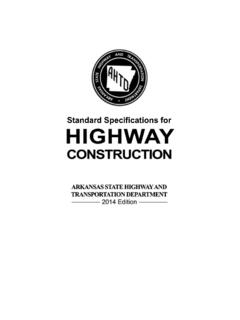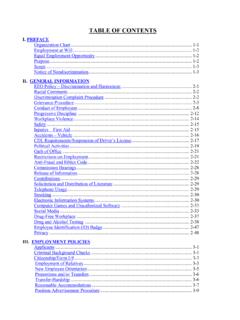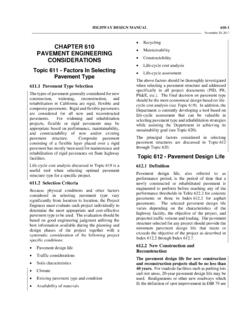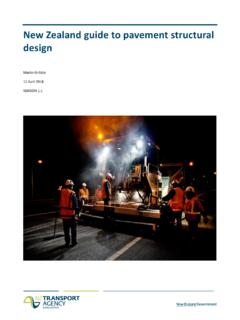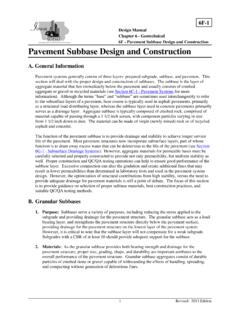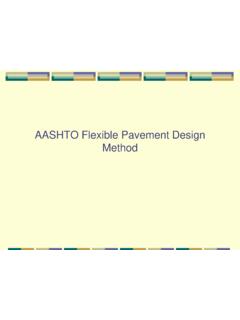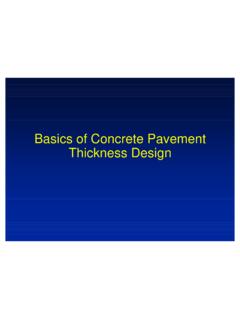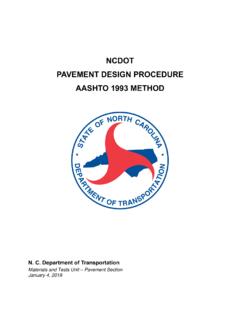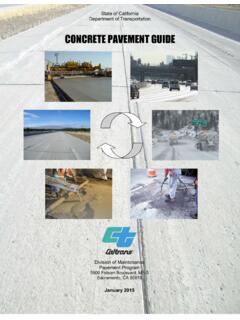Transcription of AASHTO 2002 Pavement Design Guide Design Input …
1 TRC0302. AASHTO 2002 Pavement Design Guide Design Input Evaluation Study Kevin D. Hall, Steven Beam, Meng Lee Final Report 2006. FINAL REPORT. TRC-0302. AASHTO 2002 Pavement Design Guide . Design Input EVALUATION STUDY. by Kevin D. Hall, Steven Beam, and Meng Lee Conducted by Department of Civil Engineering University of Arkansas In cooperation with Arkansas State Highway and Transportation Department Department of Transportation Federal Highway Administration University of Arkansas Fayetteville, Arkansas 72701. June 2006. TRC-0302. AASHTO 2002 Pavement Desgin Guide Design Input Evaluation Study EXECUTIVE SUMMARY. Many highway agencies use AASHTO methods for the Design of Pavement structures.
2 Current AASHTO . methods are based on empirical relationships between traffic loading, materials, and Pavement performance developed from the AASHO Road Test (1958-1961). The applicability of these methods to modern-day conditions has been questioned; in addition, the lack of realistic inputs regarding environmental and other factors in Pavement Design has caused concern. Research sponsored by the National Cooperative Highway Research Program has resulted in the development of a mechanistic- empirical Design Guide (M-E Design Guide ) for Pavement structural analysis. The new M-E Design Guide requires over 100 inputs to model traffic, environmental, materials, and Pavement performance to provide estimates of Pavement distress over the Design life of the Pavement .
3 Many designers may lack specific knowledge of the data required. A study was performed to assess the relative sensitivity of the models used in the M-E Design Guide to inputs relating to Portland cement concrete (PCC) materials in the analysis of jointed plain concrete pavements (JPCP) and to inputs relating to Hot-Mix Asphalt (HMA). materials in the analysis of flexible pavements. For PCC, a total of 29 inputs were evaluated; the three Pavement distress models (cracking, faulting, and roughness) were not sensitive to 17 of the 29 inputs. All three models were sensitive to 6 of 29 inputs. Combinations of only one or two of the distress models were sensitive to 6 of 29 inputs.
4 For HMA, a total of 8 inputs were evaluated for each of two HMA. mixtures; the three primary distress models (rutting, fatigue cracking, and roughness) were not sensitive to 6 of the 8 inputs. Distress models exhibited sensitivity to only Design air voids and effective binder content. This data may aid designers in focusing on those inputs having the most effect on desired Pavement performance. TABLE OF CONTENTS. CHAPTER ONE: Background ..1. CHAPTER TWO: Rigid Pavement Design ..8. CHAPTER THREE: Flexible Pavement Design ..46. CHAPTER FOUR: Summary and Conclusions ..92. APPENDIX A: Record of Inputs for MEPDG JPCP Analysis .. A-1. APPENDIX B: Rigid Pavement Sensitivity APPENDIX C: Record of Inputs for MEPDG Flexible Pavement APPENDIX D: Flexible Pavement Sensitivity Graphs.
5 D-1. APPENDIX E: Hot-Mix Asphalt Mixture Data ..E-1. CHAPTER ONE. BACKGROUND. Introduction The Arkansas State Highway and Transportation Department (AHTD) currently performs structural Pavement Design in accordance with policies and procedures contained in the 1993. AASHTO Guide for the Design of Pavement Structures (hereinafter the 1993 Guide ). The procedures specified in the 1993 Guide (and the previous versions released in 1972 and 1986). were developed from empirical relationships determined during the AASHO Road Test conducted from 1958 to 1961 outside Ottowa, Illinois. AASHO Road Test The principal objective of the AASHO Road Test was to determine the significant relationship between the number of repetitions of specific axle loads of different magnitude and arrangement, and the performance of different thicknesses of uniformly designed and constructed asphaltic concrete and reinforced Portland cement surfacings on different thicknesses of base and subbase when laid on a basement soil of known characteristics.
6 [1]. The AASHO test roads were located just northwest of Ottawa, Illinois, about 80 miles southwest of Chicago, whereby the climate and the soil topography of the area were typical of those in the northern United States region. The test roads were constructed entirely on embankment to meet requirements. The test roads consisted of 6 loops (1 to 6) by which loops 2. to 6 were trafficked while loop 1 was used for climatic and other observations. Each loop had two 12 ft wide traffic lanes which were independently trafficked. The test roads were subjected to truck loads moving at a constant speed of 35 mph, for about 19 hours a day over a period of about 2 years.
7 The total number of axle loads over each experimental section in the test roads was over million. The axles loads used ranged from 2 kips in single axles to 48 kips in 1. tandem axles. The subbase used on the test sections was a local plant modified sandy gravel mix. The road base used was a wet-mix crushed limestone. The Present Serviceability Concept The concept of serviceability was used to quantify the condition of each experimental Pavement section along with the more commonly used observations of major Pavement distresses such as permanent deformation and cracking. Serviceability is based on the assumption that road users are more interested in the ride quality of a Pavement rather than the extent of the structural deterioration of a Pavement .
8 A subjective assessment panel of drivers of both private and commercial vehicles was formed to assess the concept of ride quality on 99. selected lengths of roads, equally divided between flexible and concrete pavements, in the states of Illinois, Minnesota, and Indiana. Each member of the panel was asked to rate the serviceability of each road using a scale of 0 to 5 as defined in a rating form. Furthermore, each member was asked to give an overall evaluation of the acceptability of each Pavement section and whether or not the Pavement should be allowed for continued service. The purpose of the acceptability evaluation was to establish a level of acceptability in the rating scale.
9 The mean rating and the mean acceptability of the panel were used to define the present serviceability rating (PSR) of each Pavement . The results of the assessment showed that a PSR value of reflected the critical condition likely to require future attention while a PSR of indicated that the road was unfit for service [1]. With the results of the PSR ratings from 99 sites, engineers and statisticians involved in the AASHO road test produced equations relating the ride quality and major distresses to give a present serviceability index (PSI) which matched the PSR values produced from the assessment panel. 2. NCHRP 1-37a The AASHO Road Test, which at the time represented the most comprehensive Pavement Design study ever undertaken, has weaknesses which make it obsolete compared to current Pavement performance information.
10 These weaknesses are purported to be addressed with the release of new Pavement Design guidelines prepared under National Cooperative Highway Research Program (NCHRP) Project 1-37a, which was completed in 2004. The primary product of NCHRP 1-37a is the Mechanistic-Empirical Pavement Design Guide (hereinafter the MEPDG). The MEPDG utilizes a mechanistic-empirical (M-E) Design approach as opposed to the current purely empirical approach. Similar to former methods, the M-E. approach will characterize the materials, traffic, and environment using relationships developed from field experience, thus the term "empirical" The difference between the older empirical.
